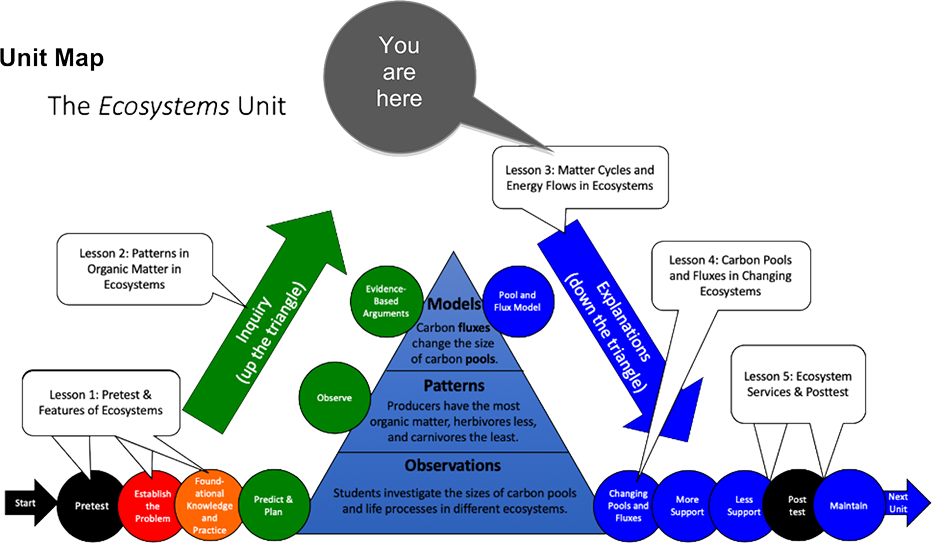Transformations in Matter and Energy Carbon TIME is an NSF-funded partnership led by Michigan State University
Ecosystems | Lesson 3 - Matter Cycles and Energy Flows in Ecosystems
Overview
In Lesson 2, students identified a pattern of the organic matter pyramid in a meadow ecosystem. In Lesson 3, they explain why that pattern exists by tracing matter and energy and connecting scales: (a) matter cycling and energy flow among carbon pools at the ecosystem scale, (b) growth, life functions, and death of organisms at the macroscopic scale, and (c) carbon-transforming processes (photosynthesis, biosynthesis, digestion, cellular respiration) at the atomic-molecular scale.
Guiding Question
How do carbon atoms and energy move through an ecosystem?
Activities in this Lesson
- Activity 3.1: Large-Scale Four Questions (20 min)
- Activity 3.2: Carbon Dice Game (30 min)
- Activity 3.3: Tracing Carbon Through Ecosystems (30 min)
- (Optional) Activity 3.4: What Happens to Soil Carbon? (30 min)
- Activity 3.5: Tracing Energy Through an Ecosystem (30 min)
- Activity 3.6: Explaining Patterns in Ecosystems (30 min)
Unit Map

Target Student Performance
|
Activity |
Target Performance |
|
Lesson 3 – Matter Cycles and Energy Flows in Ecosystems (students as explainers) |
|
|---|---|
|
Activity 3.1: Large-Scale Four Questions |
Students identify carbon pools in ecosystems and processes that move carbon atoms from one pool to another. |
|
Activity 3.2: Carbon Dice Game |
Students record and share data about their movement to different carbon pools when they play the role of carbon atoms in an ecosystem (the Carbon Dice Game). |
|
Activity 3.3: Tracing Carbon Through an Ecosystem |
Students name carbon pools and the processes that move carbon atoms among pools in terrestrial ecosystems. |
|
(Optional) Activity 3.4: What Happens to Soil Carbon? |
Students explain the role of detritus and detritus-based food chains in ecosystems. |
|
Activity 3.5: Tracing Energy Through an Ecosystem |
Students trace changes in energy and energy flow through carbon pools in ecosystems. |
|
Activity 3.6: Explaining Patterns in Ecosystems |
Students explain matter cycling and energy flow in ecosystems, answering the Carbon Pools Question, the Carbon Cycling Question, and the Energy Flow Question. |
NGSS Performance Expectations
High School
- Chemical Reactions. HS-PS1-7. Use mathematical representations to support the claim that atoms, and therefore mass, are conserved during a chemical reaction.
- Ecosystems: Interactions, Energy, and Dynamics. HS-LS2-1. Use mathematical and or computational representations to support explanations of factors that affect carrying capacity of ecosystems at different scales.
- Ecosystems: Interactions, Energy, and Dynamics. HS-LS2-2. Use mathematical representations to support and revise explanations based on evidence about factors affecting biodiversity and populations in ecosystems at different scales.
- Ecosystems: Interactions, Energy, and Dynamics. HS-LS2-4. Use mathematical representations to support claims for the cycling of matter and flow of energy among organisms in an ecosystem.
- Ecosystems: Interactions, Energy, and Dynamics. HS-LS2-5: Develop a model to illustrate the role of photosynthesis and cellular respiration in the cycling of carbon among the biosphere, atmosphere, hydrosphere, and geosphere.
- Earth’s Systems. HS-ESS2-6. Develop a quantitative model to describe the cycling of carbon among the hydrosphere, atmosphere, geosphere, and biosphere.
Middle School
- Matter and Energy in Organisms and Ecosystems. MS-LS2-1. Analyze and interpret data to provide evidence for the effects of resource availability on organisms and populations of organisms in an ecosystem.
- Interdependent Relationships in Ecosystems. MS-LS2-2. Construct an explanation that predicts patterns of interactions among organisms across multiple ecosystems.
- Matter and Energy in Organisms and Ecosystems. MS-LS2-3. Develop a model to describe the cycling of matter and flow of energy among living and nonliving parts of an ecosystem.
- Matter and Energy in Organisms and Ecosystems. MS-LS2-4. Construct an argument supported by empirical evidence that changes to physical or biological components of an ecosystem affect populations.
- Matter and Energy in Organisms and Ecosystems. MS-LS1-6. Construct a scientific explanation based on evidence for the role of photosynthesis in the cycling of matter and flow of energy in and out of organisms.
- Earth’s Systems. MS-ESS2-1. Develop a model to describe the cycling of earth’s materials and the flow of energy that drives this process.
- Human Impacts. ESS3-4. Construct an argument supported by evidence for how increases in human population and per-capita consumption of natural resources impact Earth’s systems.

 Download PDF of Lesson 3 Teacher's Guide
Download PDF of Lesson 3 Teacher's Guide